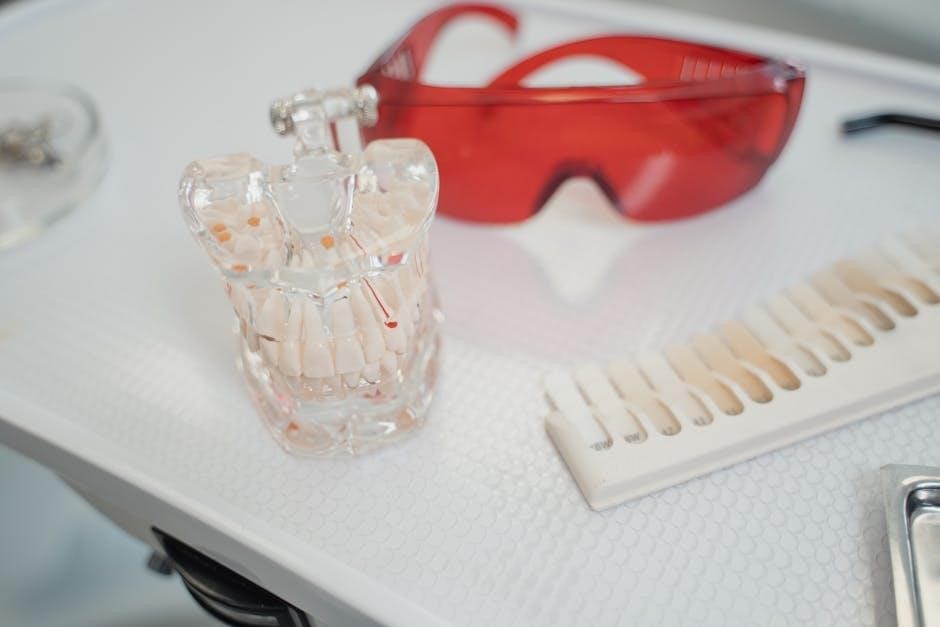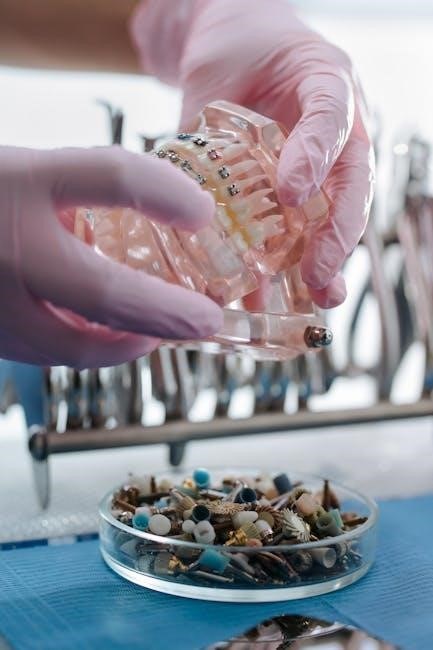Dental instruments are essential tools for diagnosing and treating oral health conditions. A pocket guide provides a concise reference‚ detailing each instrument’s purpose‚ design‚ and clinical application.
Overview of Dental Instrumentation
Dental instrumentation encompasses a wide range of tools designed for specific tasks in oral care. From basic exams to complex surgeries‚ these instruments are categorized by their functions‚ such as examining‚ probing‚ or surgical procedures. A pocket guide provides a comprehensive yet concise overview‚ detailing the purpose‚ design‚ and clinical application of each instrument. It includes photographs and descriptions‚ helping professionals identify and understand the tools they use daily. This resource is invaluable for both education and practice‚ ensuring familiarity with the instruments that are integral to delivering high-quality patient care. It bridges theory and practical application‚ making it an essential reference for dental professionals.
Importance of Familiarity with Dental Tools
Familiarity with dental tools is crucial for effective patient care and procedural efficiency. Knowing each instrument’s function and design enables precise diagnosis and treatment‚ reducing errors and enhancing patient comfort. A pocket guide serves as a quick reference‚ helping professionals master instrumentation. Proficiency builds confidence‚ allowing dentists to focus on complex procedures while ensuring accuracy. Proper tool usage also prevents cross-contamination and maintains sterilization standards. Staying updated with advancements in dental instrumentation is essential for delivering modern‚ evidence-based care. This knowledge is foundational for all dental professionals‚ fostering a safe and skilled clinical environment.

Classification of Dental Instruments
Dental instruments are categorized into basic‚ specialty‚ surgical‚ and restorative tools‚ each designed for specific procedures‚ ensuring efficiency and precision in dental care. Materials like stainless steel and titanium are commonly used for durability and sterility.
Basic vs. Specialty Instruments
Dental instruments are broadly categorized into basic and specialty tools. Basic instruments‚ such as mirrors and probes‚ are essential for routine examinations and diagnostics. They are versatile and used daily in most dental procedures. Specialty instruments‚ like orthodontic pliers or implant drills‚ are designed for specific treatments‚ requiring advanced training to use effectively. Basic tools are fundamental for every dentist‚ while specialty instruments cater to niche procedures‚ ensuring precision and efficiency. Both categories are crucial‚ with materials like stainless steel and titanium ensuring durability and sterility.
Common Materials Used in Manufacturing

Dental instruments are crafted from high-quality materials to ensure durability and sterility. Stainless steel is widely used for its resistance to corrosion and ability to withstand sterilization. Titanium is favored for its biocompatibility and strength‚ particularly in implants. Tungsten carbide is employed in cutting instruments due to its hardness. Other materials include ceramic‚ plastic‚ and rubber‚ which are used for handles and disposable components. These materials are chosen for their ability to maintain hygiene‚ comfort‚ and precision in dental procedures‚ ensuring both patient safety and instrument longevity.
Basic Dental Instruments
Basic dental instruments are essential for everyday dental procedures‚ ensuring efficient diagnosis and treatment. A pocket guide provides detailed insights into these fundamental tools‚ highlighting their roles and applications in clinical settings. It serves as a comprehensive resource for dental professionals‚ offering clear descriptions and illustrations to aid in identification and understanding. This guide is indispensable for students and practitioners alike‚ fostering familiarity with the instruments that form the backbone of dental care.
Dental Mirrors and Explorers
Dental mirrors and explorers are fundamental tools in dental diagnostics. Mirrors provide indirect vision‚ enabling visualization of inaccessible areas‚ while explorers detect surface irregularities like decay. Together‚ they enhance precise examination‚ aiding in early detection of oral issues. Their design‚ with rounded mirror ends and fine explorer tips‚ ensures patient comfort during procedures. These instruments are indispensable for accurate diagnoses‚ guiding effective treatment plans and maintaining oral health. A pocket guide offers detailed insights‚ helping professionals master their use‚ ensuring comprehensive care in every dental setting.
Probing and Measuring Instruments
Probing and measuring instruments are vital for assessing oral health and diagnosing conditions like periodontal disease. Periodontal probes measure pocket depths and sulcus‚ while calipers assess tooth wear or restoration margins. These tools feature markings for precise measurements‚ ensuring accurate data collection. Probing instruments‚ such as the PCP probe‚ are used for periodontal charting‚ while others measure orthodontic alignments or implant placements. Their ergonomic designs enhance comfort during use‚ allowing for thorough examinations without causing patient discomfort. Proper use of these instruments is essential for effective treatment planning and maintaining optimal oral health outcomes. A pocket guide provides detailed insights‚ helping professionals master their application in clinical settings.
Specialized Dental Instruments
Specialized dental instruments cater to advanced procedures‚ including surgery‚ orthodontics‚ and implantology‚ offering precision and functionality for complex treatments‚ enhancing patient care and procedural outcomes significantly.
Surgical and Orthodontic Tools
Surgical and orthodontic tools are specialized instruments designed for precise and intricate procedures. They include scalers‚ forceps‚ retractors‚ and orthodontic pliers‚ each tailored for specific tasks like tissue manipulation or bracket placement. These tools are crafted from high-grade materials like stainless steel or titanium for durability and sterility. The pocket guide provides detailed descriptions‚ highlighting their unique features and clinical applications. Understanding these instruments is crucial for dental professionals to ensure accurate diagnoses and effective treatments‚ especially in complex cases requiring surgical intervention or orthodontic adjustments. Proper use and maintenance of these tools are emphasized to optimize patient outcomes and procedural success rates.
Implantology and Restorative Instruments
Implantology and restorative instruments are crucial for procedures involving dental implants and reconstructive treatments. These tools include drills‚ surgical guides‚ and healing abutments for implant placement‚ as well as composite resin injectors and polishing burs for restorative work. Made from materials like titanium and stainless steel‚ they ensure durability and sterility. The pocket guide details each instrument’s role‚ such as impression trays for precise molds or implant drivers for secure placement. Understanding these tools is vital for achieving accurate implant positioning and restoring dental function aesthetically. Proper use of these instruments ensures successful outcomes‚ whether for single-tooth implants or complex full-mouth restorations‚ enhancing patient satisfaction and oral health.

Instrument Sterilization and Maintenance

Proper sterilization and maintenance of dental instruments are vital for infection control. Techniques include ultrasonic cleaning‚ autoclaving‚ and chemical disinfection. Regular upkeep ensures longevity and safety.

Proper Cleaning and Disinfection Techniques
Proper cleaning and disinfection of dental instruments are critical for preventing infection and ensuring patient safety. The process begins with removing debris using ultrasonic cleaners or manual scrubbing. Instruments are then disinfected using chemical solutions or autoclaved for sterilization. Heat-resistant tools are typically autoclaved‚ while heat-sensitive instruments may require chemical disinfection. Following manufacturer guidelines is essential to maintain instrument integrity. Regular cleaning and disinfection protocols help prevent cross-contamination and extend the lifespan of dental tools. Proper techniques ensure that instruments remain effective and safe for use in various dental procedures.
Storage and Organization Best Practices
Proper storage and organization of dental instruments are vital for maintaining sterility‚ preventing damage‚ and ensuring efficiency in clinical settings. Instruments should be stored in clean‚ dry environments‚ away from direct sunlight and moisture. Autoclave bags or sealed containers are ideal for storing sterilized tools‚ labeled with their contents and sterilization dates. Organizing instruments in trays or compartments prevents clutter and allows for quick access. Regularly reviewing storage areas to remove outdated or damaged items is essential. Labeling and categorizing instruments by type or procedure ensures easy retrieval‚ enhancing workflow and reducing the risk of contamination or misplacement.

Dental instruments play a crucial role in modern dentistry‚ enabling precise treatments and diagnoses. Understanding their proper use and maintenance enhances patient care and professional efficiency.
Key Takeaways for Dental Professionals
Familiarity with dental instruments is vital for effective patient care. Understanding their functions‚ proper sterilization‚ and organized storage enhances efficiency. Staying updated on advancements ensures adaptability to new techniques and materials. Effective communication with patients about instrument use builds trust. Regular maintenance of tools prolongs their lifespan and ensures precision. These practices collectively contribute to improved clinical outcomes and patient satisfaction‚ making dental professionals more confident and competent in their roles. By mastering these elements‚ professionals can deliver high-quality care consistently.
Future Trends in Dental Instrumentation
The future of dental instrumentation is poised for significant advancements‚ driven by technological innovation and patient demand. Digital tools‚ such as CAD/CAM systems‚ are becoming more prevalent‚ enabling precise restorations. Miniaturized instruments and robotic-assisted dentistry are emerging‚ enhancing accuracy and reducing invasiveness. Biocompatible materials and nanotechnology are expected to improve instrument durability and patient safety. AI integration will likely optimize instrument design and clinical decision-making. Ergonomic designs will reduce fatigue for professionals. These trends promise to elevate dental care‚ making procedures more efficient‚ patient-friendly‚ and outcomes-driven. Staying informed about these developments will be crucial for dental professionals to adapt and thrive in a modernizing field.

